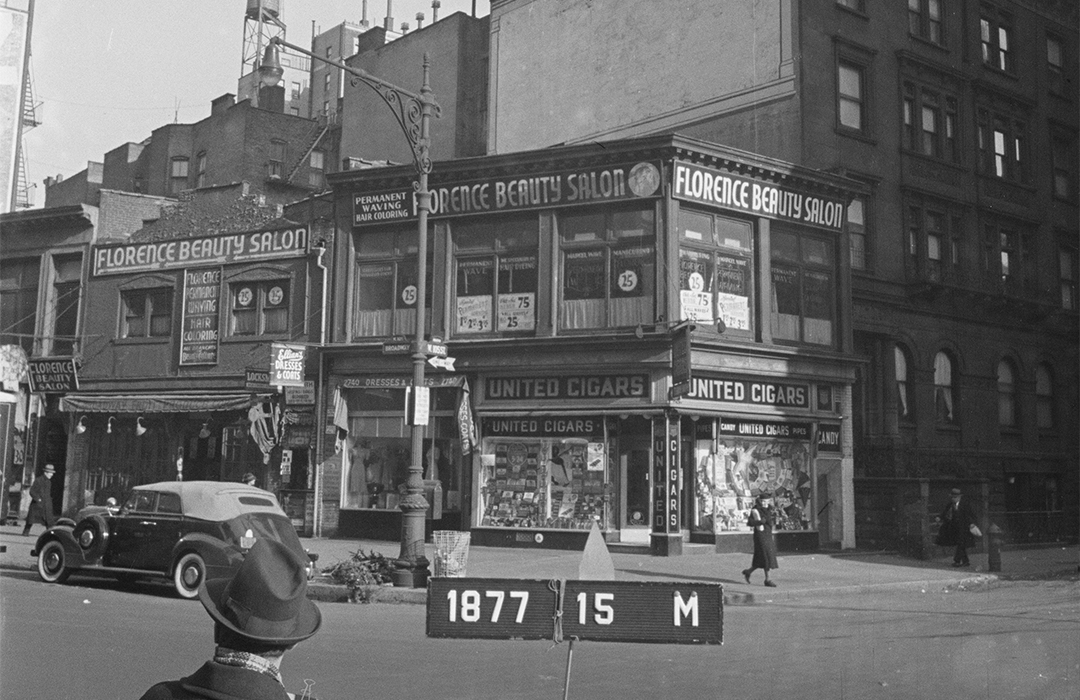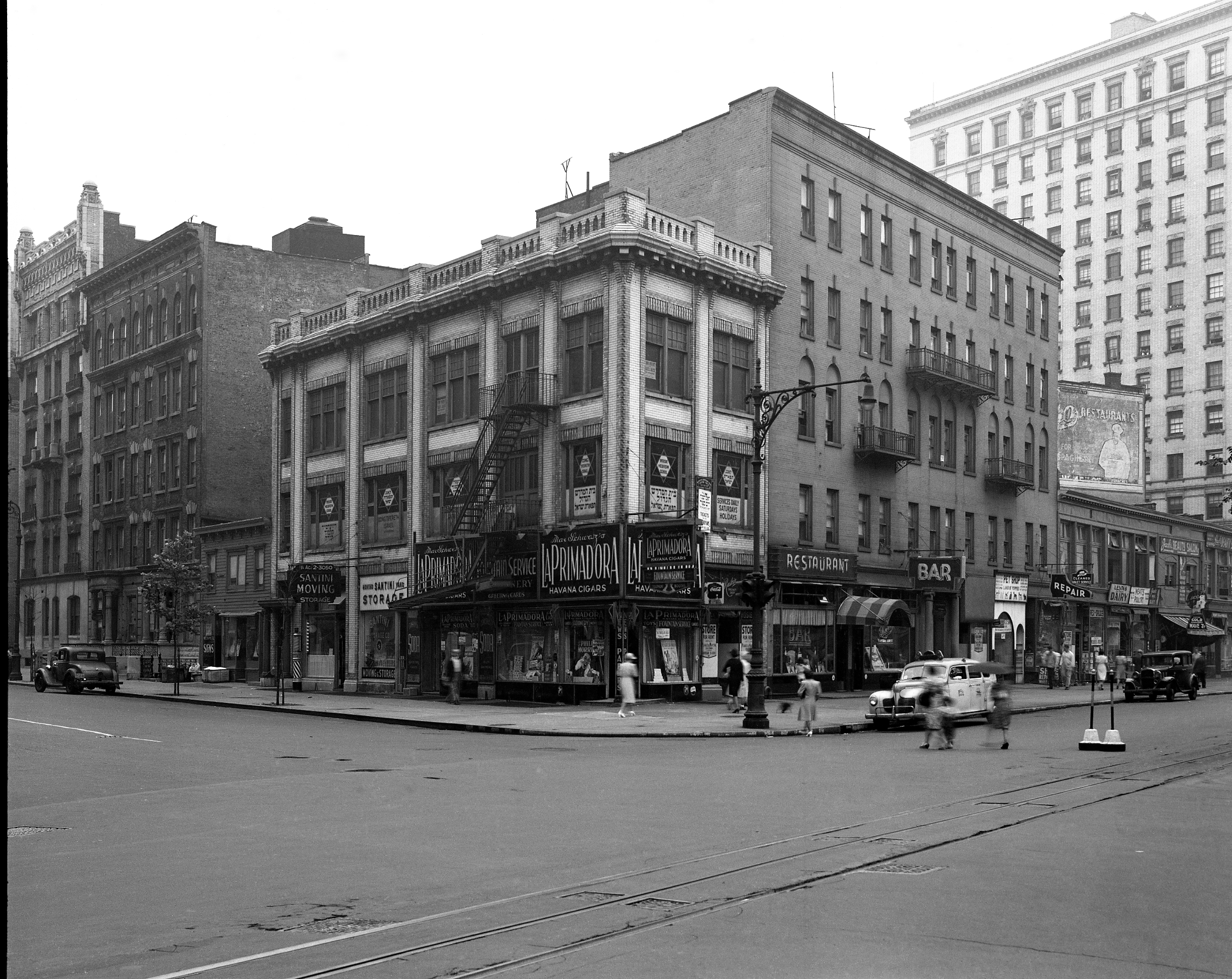
2740-2748 Broadway
by Tom Miller
Benjamin F. Luyster was the son of the well-known builder C. W. Luyster. Late in 1919, he partnered with Thomas S. Quinn to form the real estate development firm of Luyster & Quinn. On December 6, the Real Estate Record & Guide reported that they had opened offices at 2740 Broadway, adding, “The new firm are erecting two flats on West 133d st.”
The two-story building into which they moved was one of four recently erected “taxpayers” at 2740 through 2748 Broadway (one of them took two addresses, at 2742-2744). Taxpayers were small structures, often temporary, which gleaned enough rental income to pay the property taxes. The upper floors held offices, such as the one Luyster & Quinn rented, while stores occupied street level. In the case of 2740 Broadway, it was Michael J. Murray’s fish and oyster market.
At the far end of the row, John McDermott’s undertaking establishment was at 2748 Broadway. The funeral home would remain in the space until around 1925, after which it became Philip Koshen’s interior decorating shop. He advertised his business “for painting and decorating of the superior kind.”
In 1917 the Segall Window Shade Cleaning Co. took over the second-floor spaces of 2744 through 2748 Broadway. An advertisement in 1919 cautioned, “Do not destroy your old window shades, we clean them equal to new at 1-3 cost of new shades. We are also mfrs. Of all kinds of shades. Look us up and give us a trial.”
Joseph came from an unlucky gangland family.
In the ground floor space of 2744, that year was George W. Rhode’s retail art store. Rhodes had been in the art business since the 1880s, serving as the picture buyer for several department stores over the years before opening his own shop.
Samuel Tilkin owned the row, and despite having a common tenant on the second floor of three of the buildings, he gave 2742-2744 an Arts & Crafts style facelift around 1917. The second-story windows were reduced in size, and a stepped parapet replaced the cornice. Tilkin sold the row in September 1925 to the Kaypen Realty Corporation.
In 1919 a fur store, Mantzuras & Co., opened in 2744 Broadway. Its tenancy would be short-lived. On September 24, 1921, an advertisement in the New York Herald offered the store for rent at $3,000 per year. It became Charles Segal’s upholstery and decorating store. (The similarity of his surname with the Segall Window Shade Cleaning Co. upstairs is impossible to ignore.)
By 1933 Segall Window Shade Cleaning Co. was gone, and the upper floors were again rented to individual tenants. The space at 2744 Broadway initially became an illegal club. On the morning of October 2, 1933, “Joseph (Spot) Leahy was found with his throat cut on a stairway leading to a speakeasy at 2744 Broadway,” according to the Brooklyn Daily Eagle. Joseph came from an unlucky gangland family. His 16-year-old brother Francis had been shot to death in a poolroom at 88 Columbus Avenue on New Year’s Eve, 1923. Four years after Joseph’s body was discovered, his brother William “got it as he stepped out of a pool room on the east side of 10th Ave. at 49th St.,” as reported by the Brooklyn Daily Eagle.
In 1935 the speakeasy became the headquarters of the National Union for Social Justice, a Communist group. The name would later be changed to the James Connolly Branch of the American Communist Party, and the space renamed the Unity Center. The address was closely monitored by the Government. In Congressional hearings held in 1953, evidence was presented that “in 1945, at a meeting of the [Communist] Party’s 11th A[ssembly] D[istrict] Club, whose headquarters was in 2744 Broadway, Goldie Young, Party Organizer, urged all comrades to support the VALB’s annual Christmas dinner and dance.” The VALB was the Veterans of the Abraham Lincoln Brigade, considered to be a subversive group.
On May 3, 1947, the Police Department Bomb Squad was called to 2744 Broadway where, according to the Brooklyn Eagle, “an alarmed voice had reported by telephone, a ‘bomb’ had been discovered outside the door of the Unity Center, a Communist Party Club.” Police evacuated the five female patrons of Jack’s Beauty Parlor “in the process of being beautified” while at the same time “emptying the Communist club in about no minutes flat,” said the article. The investigators found a black, cylindrical container marked “60 MM. SHELL.” But, oddly enough, water was seeping from it. Inside it, the police found ice cubes. The Brooklyn Eagle concluded its article by saying, “Who, if anyone, had ordered ice cubes remained a mystery.”
Police evacuated the five female patrons of Jack’s Beauty Parlor “in the process of being beautified” while at the same time “emptying the Communist club in about no minutes flat..”
Four decades after it opened, the Unity Center was known as the Upper West Side Forum Hall. Here on September 16, 1973, a fundraiser was held for the Fort Worth Five. The Advocate explained, “The Fort Worth Five are a group of Irish activists imprisoned by the Federal government in Texas for refusing to testify before a Grand Jury investigating activities of Irish organizations.”
In the meantime, the ground-floor shops were less controversial. In 1933 the Radio Service Co. store occupied 2740 Broadway, and by 1966 the Lomore Delicatessen was in 2746. Next door at 2748, the Siam Grocery Store, where Thai ingredients could be found, was in place by the late 1970s.
At some point in the second half of the 20th century, the parapet at 2744 Broadway was removed, and replaced by a cornice that attempted to restore architectural conformity to the row.
Tom Miller is a social historian and blogger at daytoninmanhattan.blogspot.com
BUILDING DATABASE
Keep Exploring
Be a part of history!
Think Local First to support the businesses at 2740-2748 Broadway:
Meet Iva Smith!



